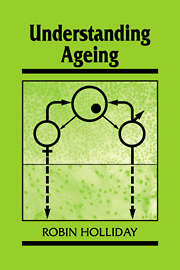Book contents
- Frontmatter
- Contents
- Preface
- Author's note
- Acknowledgements
- 1 Introduction
- 2 The evolved anatomical and physiological design of mammals
- 3 Maintenance of the adult organism
- 4 Theories of ageing
- 5 Cellular ageing
- 6 Genetic programmes for ageing
- 7 The evolution of longevity
- 8 Human disease and ageing
- 9 A better understanding of ageing
- Notes
- References
- Author index
- Subject index
3 - Maintenance of the adult organism
Published online by Cambridge University Press: 31 March 2010
- Frontmatter
- Contents
- Preface
- Author's note
- Acknowledgements
- 1 Introduction
- 2 The evolved anatomical and physiological design of mammals
- 3 Maintenance of the adult organism
- 4 Theories of ageing
- 5 Cellular ageing
- 6 Genetic programmes for ageing
- 7 The evolution of longevity
- 8 Human disease and ageing
- 9 A better understanding of ageing
- Notes
- References
- Author index
- Subject index
Summary
The growth and development of the mammalian organism to the adult is normally followed by a reproductive phase, which comprises a considerable part of the whole lifespan. The adult organism is not in equilibrium or a steady state, but it retains all its physiological functions for a long period, which allows it to search for food, reproduce and care for its offspring. During this period, as well as during development, these functions are maintained by a variety of mechanisms. Some of the major maintenance mechanisms are described in this chapter.
DNA REPAIR
The DNA genome is the repository for all the genetic information of any species. It is essential that the integrity of this information be protected, both during the division of somatic cells and in its transmission from generation to generation. The intact DNA is subject to a wide variety of defects and damage, which are normally repaired. The study of DNA repair mechanisms was pioneered in bacteria and bacteriophages, but there is now much direct and indirect information about repair mechanisms in higher organisms as well (reviewed by Friedberg 1985; Sedgwick 1986). Repair processes can be broadly divided into those that act on so-called spontaneous changes in DNA, and those that act on DNA that has been damaged by radiation or chemical attack.
- Type
- Chapter
- Information
- Understanding Ageing , pp. 21 - 40Publisher: Cambridge University PressPrint publication year: 1995



